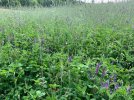yoderjac
5 year old buck +
In Louisiana, Durana was the backbone of all my plots. I used oats with it. It is a great combo. In Kentucky, I've had great utilization on crimson from fall through spring. As with anything, climate location and equipment can dictate what's best for your scenario. Experiment until you find what works. I used to do soybeans, jointvetch, cowpeas, wheat, oats, and anything else I could get my hands on. I don't really get too in depth with foodplots anymore. I use them as just a viewing/shooting stage. My focus is getting the other 95% of my property clicking.
Really good point! 90% of our QDM improvement has come from large scale timber management. Food plots are tiny fraction of a deer's diet. From a QDM perspective their primary purpose is to provide a quality food source during the stress periods when nature is stingy. Outside that, they don't benefit deer. It doesn't matter if a deer is eating a quality food I planted or a high quality weed or other native food. It is only when quality native foods are absent that food plots benefit the herd.
If a guy is real lucky, maybe he has 5% of his deer's home range in food plots. Most have less to much less. When we improve native foods through large scale things like opening the canopy, conducting controlled burns, and such, we are addressing that 95% of a deer's diet that food plots don't address.
Thanks,
Jack


